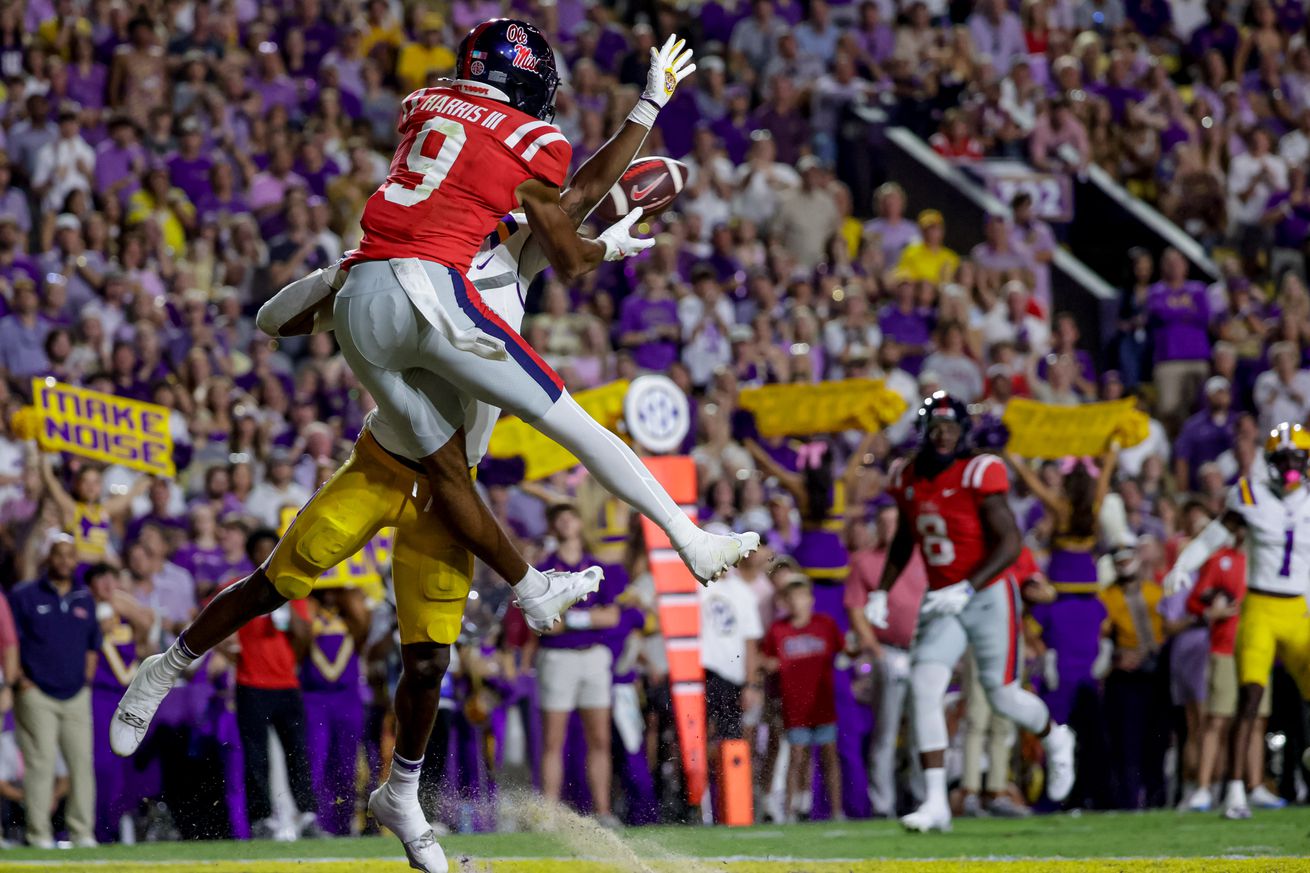
Looking for WRs who were the best at all the things that receivers do
Continuing my series of draft position roundups, focusing on skillsets the Commanders need to raise their talent ceiling and rebuild the depth pipeline, I’d like to switch back to offense. But, in case you missed the previous roundups, here they are:
Late Round Running Backs
Offensive Linemen Who Can Help the Running Game
Ball-hawking Cornerbacks
Ball-hawking Safeties
Edge Defenders Who Can Disrupt the QB and Stop the Run
Adam Peters made a big off-season move to bring in Deebo Samuel to give Kliff Kingsbury another playmaker. Deebo is a one year rental, and joins Terry McLaurin to give Jayden Daniels another playmaker to get the ball to. But the offense is still thin on game-breaking talents.
With a need for youth on both sides of the ball, this would be a good time to draft a dynamic receiver to help the Commanders compete for championships during the course of Jayden Daniels’ rookie contract. The WR class has been billed as weak, because it is short on first round talents. But it is very deep, particularly if you like big WRs. There could be an opportunity to add a developmental WR with upside even late into Day 3.
Wide receiver is notoriously difficult to project to the NFL. Every year, the NFL hosts the Scouting Combine and WRs who test well shoot up media draft boards. This year was no different, and Texas WR Matthew Golden, Missouri’s Luther Burden III, Iowa’s Jayden Higgins, and Maryland’s Tai Felton, all enjoyed boosts to their draft stock with standout performances. Some of the stars of the underwear Olympics go on to have successful NFL careers. But every year, others don’t.
My favorite NFL Combine stat is that the greatest WR of all time, Jerry Rice, ran a 4.71 sec 40 time. It’s actually a myth. Nobody appears to have recorded Rice’s actual 40 time. According to 49ers’ coach Bill Walsh, Rice ran in the vicinity of 4.6 sec. But on tape, Walsh and his scouting team saw a player who moved faster than his 40 time, with exceptional movement skills and route running ability.
The 49ers picked Rice 16th overall in the 1985 draft, and got a steal. I can just imagine what would happen if Adam Peters used his first round pick on a small school WR, who ran a 4.6 forty. It would be pandemonium. Scott might have to close Hogs Haven for a few days to let things cool off.
In today’s NFL, measurables matter. That might be one reason that there is no difference in player outcomes between WRs drafted in the first and second rounds. Adam Peters’ $17.5 million offseason addition was a second round pick. So were the Eagles’ A.J. Brown and Steelers’ D.K. Metcalf and George Pickens. In fact, every season seems to feature a WR picked later in the draft outperforming premium prospects taken in the first round, such as Ladd McConkey (34th, 9th WR drafted), Puka Nacua (177th), Pickens (52nd), Amon-Ra St. Brown (112th), and Darnell Mooney (173rd).
Why do teams have such a hard time sorting the winners from the busts in the early rounds, and what is it that they are overlooking in the late round surprises? If I knew the answer to that, I’d be making big bucks working for an NFL team. I suspect that one contributing factor is being wowed by traits and measurables, which might draw attention from players who are just good at football.
This roundup is my attempt to see through the hype and identify players who excelled at playing WR in college. I ranked players by 13 different productivity stats and ratings which were selected to measure different facets of playing WR. Of course, productivity at the college level is no guarantee of NFL success. But what you will find is that a lot of WRs who were overlooked by NFL teams until later in the draft had exceptional productivity in college.
Methods: Players were initially sorted by productivity stats. Then I culled those who ranked higher than 400 on the Mock Draft Database Consensus Board, to keep it to players that readers might have heard of and have a chance of being drafted. Most of the rankings considered draft-eligible WRs with a minimum of 34 (20% of max) or 50 targets for statistical reliability. A few exceptions were made where needed, and I occasionally culled unknown players with consensus ranks over 300. Consensus ranks for top 100 players are from The Athletic’s Consensus Draft Board. After that, I used the Mock Draft Database Consensus Board.
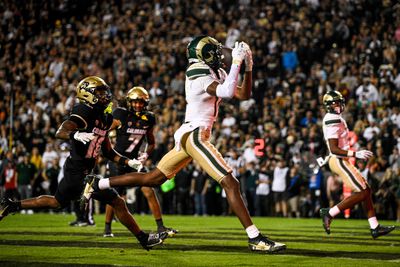
Photo by Dustin Bradford/Getty Images
Most Productive Receiver
Receiving Yardage – Y/RR
The most commonly used receiving production stat is total receiving yards. Total yardage is misleading when comparing receivers, since it does not factor in differences in playing time. One WR might have more receiving yards than another because he’s more productive, or he might have played in a few more games. Yards Per Route Run (Y/RR) provides the most accurate correction to tell who is really the most productive receiver per unit of playing time.
Class Leader: Tre Harris, Ole Miss, 5.12 Y/RR
78.9% rec rate |12.0 yd ADOT | 1,030 yds | 7 TD | 7.7 YAC/rec | 61.5% CTC | 7.7% drops
Consensus Rank: 68
The Rebels’ Tre Harris led the NCAA in Y/RR, and was far and away the most productive WR in the draft class. The next closest draft-eligible WR that anyone has heard of was Dont’e Thornton Jr. at 3.72 Y/RR, which is still an elite figure. Harris was simply on another planet from the rest of the NCAA in terms of opportunity-adjusted receiving productivity.
Honorable Mentions:
Dont’e Thornton, Tennessee, 3.72 Y/RR (consensus rank 150)
Tory Horton, Colorado, 3.45 Y/RR (consensus rank 114)
Jalen Royals, Utah St, 3.00 Y/RR (consensus rank 72)
Elijhah Badger, Florida, 2.96 Y/RR (consensus rank 278)
Ricky White, UNLV, 2.93 Y/RR (consensus rank 185)
Tetairoa McMillan, Arizona, 2.87 Y/RR (consensus rank 7)
Pat Bryant, Illinois, 2.83 Y/RR (consensus ran: 178)
Y/RR is the best overall measure of receiving productivity, but it can conflate target share with receiving ability, artificially inflating the productivity of good receivers in bad WR lineups. I also ranked the WRs by Yards per target, which is independent of target share, and Harris remained on top. Elijhah Badger and Pat Bryant also rank highly by either metric.
Tre Harris Vs. LSU is why GM’s will be ALL over him in the 2025 NFL Draft:
➖7 Receptions
➖102 Yards
➖1 TDHe CLEARED 1,000+ Yards this season while essentially missing 6 games..
His healthy 13 Game Pace?
➖110 Receptions
➖1,833 Yards
➖11 TD’sTre Harris is 6’3, 210 lbs pic.twitter.com/A9JGqTFYET
— Austin Abbott (@AustinAbbottFF) February 17, 2025
Receiving TDs – TD/RR
The other side of productivity is scoring. To identify the most prolific TD machine, I ranked the draft class by receiving touchdowns as a percentage of routes run.
Class Leader: Tre Harris, Ole Miss, 3.5% TD/RR
Harris was the most productive WR in the class at scoring and yardage. He wasn’t as far out ahead in this category as in Y/RR, but he still enjoyed a comfortable margin.
Honorable Mentions:
Kyle Williams, Washington State, 3.2% TD/RR (consensus rank 110)
Nick Nash, San Jose State, 3.14% TD/RR (consensus rank:165)
Ricky White, UNLV, 3.13% TD/RR (consensus rank 185)
Tez Johnson, Oregon, 2.89% TD/RR (consensus rank 95)
Pat Bryant, Illinois, 2.87% TD/RR (consensus rank 178)
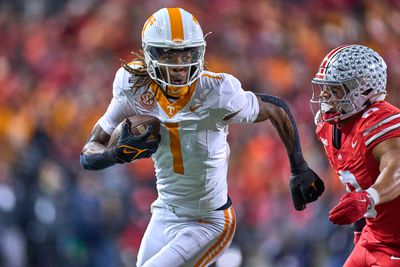
Photo by Robin Alam/ISI Photos/Getty Images
Best Creator After the Catch
Yards After the Catch/Reception
Class Leader: Dont’e Thornton Jr., Tennessee – 10.7 YAC/Rec
6-5, 205 lbs | 4.3 sec 40 | 1.53 sec 10-yd | RAS 9.80
76.5% rec rate | ADOT 16.5 yds | 662 rec yds | 6 TD | 3.72 Y/RR | 7.1% drops | 3/4 CTC (75%)
Consensus Rank: 150
Baltimore native Thornton is a big, explosive, vertical playmaker, who runs a 4.3 sec 40, and catches everything thrown his way. If you believe the Consensus Board, some lucky team might land him in the fifth round. His combination of play strength to make difficult catches and breakaway speed separate him from the rest of the WR class in generating yardage after the catch. I suspect the consensus will prove wrong.
Honorable Mentions:
Samuel Brown, Miami, 8.5 YAC/Rec (consensus rank 263)
Kyle Williams, Washington State, 8.4 YAC/Rec (consensus rank 110)
Antwane Wells Jr, Ole Miss, 8.3 YAC/Rec (consensus rank 235)
Jaylin Lane, VA Tech, 8.3 YAC/Rec (consensus rank 203)
Isaiah Bond, Texas, 8.0 YAC/Rec (consensus rank 89)
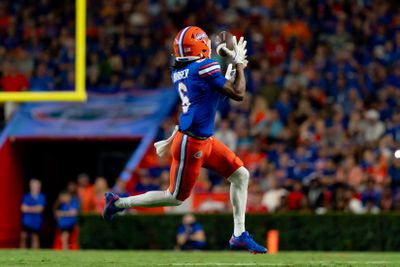
Photo by Chris Leduc/Icon Sportswire via Getty Images
Best at Catching the Football
Reception Rate Over Expectation
Gaining separation is often promoted as the key to receiving success at the NFL level. Separation is important, but there is something even more important, which might help to explain why the most hyped first round prospects are often not the best WRs in their draft class. It doesn’t help much to get wide open if you don’t catch the football.
Reception Rate is often cited as a metric of catching ability. On its own, it is uninformative. The reason for that is that Reception Rate strongly depends on the depth of the route tree that a receiver runs. Receivers who make their living running deep routes tend to have lower Reception Rates than those who work closer to the line of scrimmage. To illustrate what I mean, here is a plot of Reception Rate for 142 draft-eligible WRs (min 50 targets), as a function of Average Depth of Target (ADOT):
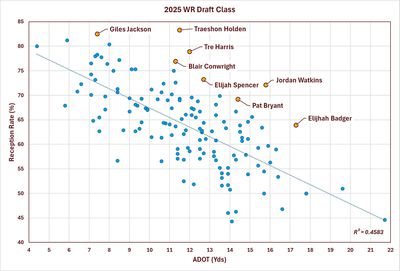
There is a strong tendency for reception rate to decline with increasing ADOT. As a predictive variable, ADOT accounts for around 46% of the variance in Reception Rate. The rest of the variance around the trend line presumably reflects individual differences in receiving ability and QB accuracy.
Setting aside QB play, temporarily, the best WRs at hauling in the football are likely to be found among those who sit the farthest above the trend line. My metric for ball catching ability is just the vertical distance between a WR’s data point in this plot and the trend line, which I refer to as Reception Rate Over Expectation (RROE). The candidates for class leader are color coded as future Commanders.
Class Leader: Traeshon Holden, Oregon, RROE 18.8%
6-2, 205 lbs | 4.57 sec 40 | 1.54 sec 10-yd | RAS 6.39
83.3% rec | ADOT 11.5 yds | 718 yds | 5 TD | 1.99 Y/RR | 6.2 YAC/rec | 62.5% CTC | 6.3% drops
Consensus Rank: 339
The Oregon Duck’s Traeshon Holden hasn’t got as much media attention as his teammate Tez Johnson. That might have a lot to do with his 4.57 sec 40 time. He is great at catching the football. His 83.3% reception rate would stand out regardless. It is 18.8% higher than you would expect based his depth of routes, which makes him the outlier of the draft class. He also grades well as a run blocker. He might be worth a flier in the later rounds or after the draft.
Honorable Mentions:
Jordan Watkins, Ole Miss, RROE 16.1% (consensus rank: 341)
Tre Harris, Ole Miss, RROE 15.4% (consensus rank: 68)
Elijhah Badger, Florida, RROE 10.6% (consensus rank: 278)
Pat Bryant, Illinois, RROE 10.3% (consensus rank: 178)
Matthew Golden, Texas, RROE 9.3% (consensus rank: 23)
LaJohntay Wester, Colorado, RROE 9.0% (consensus rank: 227)
Drop Rate
A number of factors contribute to RROE besides catching ability, including ball tracking, ability to separate from defenders, and QB accuracy. Drop Rate helps to filter out some of that noise, because it’s largely free of QB influence. A drop is only counted when PFF’s analysts determine the ball was catchable, so we don’t have to worry about QBs throwing out of the receiver’s reach.
Class Leader: Elijhah Badger, Florida, 0 drops/61 targets = 0% Drop Rate
6-1, 200 lbs | 4.43 sec 40 | 1.53 sec 10-yd | RAS 9.3
63.9% rec | ADOT 17.3 yds | 806 yds | 4 TD | 2.96 Y/RR | 6.4 YAC/rec | 11/16 CTC (68.8%) | 0 drops
Consensus Rank: 278
The Gators’ Elijhah Badger is a good bet to outperform his draft status. He is good at just about every aspect of WR play except blocking, which he has the frame to develop. He is a sure handed receiver with good extension to provide a wide catch radius, on top of being a good route runner and elusive with the ball in his hands. The 0% drop rate in 2024 is not a fluke. Over the past two seasons, he dropped just 2 out of 160 passes (1.25%). He was highly productive through his final three seasons at Arizona State and Florida. I have no idea why pundits view him as a late round prospect or UDFA. His 40 time isn’t even slow for a WR his size. He looks like a major sleeper in the draft class.
2025 wide receiver prospect Elijah Badger vs Man Press.
Badger transferred from Arizona St. to Florida (SEC) in 2024.
In 2024, he posted a career-high 2.97 YPRR (second only to Tre Harris among SEC WRs with at least 800 receiving yards).
Badger is flying under the radar. pic.twitter.com/zYmPFw83nT
— Zareh Kantzabedian (@ZKantzFF) March 10, 2025
Honorable Mentions:
Jack Bech, TCU, 1.6% (consensus rank 66)
Kaden Prather, Maryland, 1.8% (consensus rank 176)
Pat Bryant, Illinois, 1.8% (consensus rank 187)
Jayden Higgins, Iowa State, 2.2% (consensus rank 56)
Contested Catch Rate
Catching balls in the open field is one thing. A receiver who can make tough catches in traffic adds another dimension to the offense. To find out which WRs were the best at muscling out defenders, the prospects were ranked by PFF’s Contested Catch Rate (min. 5 contested targets).
Class Leader: Savion Williams, TCU, 8/9 Contested Catches = 88.9%
6-4, 222 lbs | 4.48 sec 40 | 1.52 sec 10-yd
72.3% rec | ADOT 6.6 yds | 611 yds | 6 TD | 2.10 Y/RR | 6.9 YAC/rec | 11.8% drops
Consensus Rank: 91 (Mock Draft Database; The Athletic – unranked)
Williams is a large, explosive, dual threat WR who draws comps to Cordarrelle Patterson. As a receiver, he specializes in gaining yards after the catch on short passes, where he becomes a size mismatch against CBs and a speed mismatch against LBs. He has no problem defeating press coverage and is a bully to take the ball away at the catch point.
Honorable mentions:
Isaac TeSlaa, Arkansas, 5/7, 71.4% (consensus rank 244)
Ja’Corey Brooks, Louisville, 16/23, 69.6%, (consensus rank 320)
Pat Bryant, Illinois, 9/13, 69.2% (consensus rank 187)
Elijhah Badger, Florida, 11/16, 68.8% (consensus rank 274)
LaJohntay Wester, Colorado, 8/12, 66.7% (consensus rank 220)
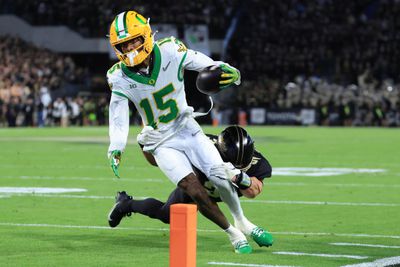
Photo by Justin Casterline/Getty Images
Best Chain Mover
Per Route Conversion Rate
The ideal metric to quantify receivers’ ability to move the chains, is Receiving Success Rate. Unfortunately, it does not appear to be calculated for NCAA football, and it’s not easy to do yourself. As a next best approximation, I calculated Receiving Conversion Rate, which is just the percentage of routes run resulting in a first down or score. Normalizing by routes run takes in the receiver’s ability to get open and draw targets in crucial game situations, which would be overlooked if we only looked at plays on which a receiver was targeted.
Class Leader: Tre Harris, Ole Miss, Per Route Conversion Rate 21.9%
Honorable Mentions:
Tez Johnson, Oregon, 17.63% (consensus rank 95 per Mock Draft Database)
Ricky White, UNLV, 17.61% (consensus rank 191)
Nick Nash, San Jose State, 17.06% (consensus rank 167)
Jayden Higgins, Iowa State, 16.85% (consensus rank 56)
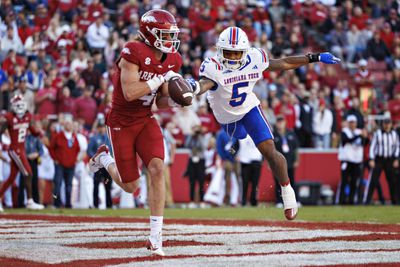
Photo by Wesley Hitt/Getty Images
Best Deep Threat
Reception Rate – Passes > 20 Yds
Rather than repeat the laborious Reception Rate Over Expectation analysis for long passes, I took a quick and dirty approach, using PFF’s receiving depth stats to look at receiving performance on passes of 20 yards and longer. First up is Reception Rate. ADOT of each WR’s deep target sample is provided to help interpret the Rec Rate figures.
Class Leader: Isaac TeSlaa, Arkansas – 77.8%, ADOT 28.7 yds
6-4, 214 lbs | 4.43 sec 40 | 1.51 sec 10-yd | RAS 9.97
77.8% rec | ADOT 14.3 yds | 532 yds | 3 TD | 1.98 Y/RR | 6.0 YAC/rec | 5/7 CTC (71.4%) | 0 drops/36 Tgt
Deep Routes (>20 yds): 7/9 catches, 277 yds, 2 TD
Consensus Rank: 244
If you flip back to the graph of ADOT vs Reception Rate, you will appreciate that a 77.8% reception rate on passes averaging 28.7 yds is phenomenal. How a 6-4 WR who runs a 4.43 sec 40 and never dropped a ball in 100 targets in the SEC flew under the media radar is anyone’s guess. TeSlaa only played two seasons for the Razorbacks, and had a mini breakout as a senior, before making a splash at the Senior Bowl. He is a big slot receiver who uses his frame and play strength to mismatch and dominate defenders. His best football is ahead of him. He has “Adam Peters Late Round Gem” tattooed on his chest.
TeSlaa’s 36 targets in 2024 fell under the 50 target threshold for the RROE analysis above, but we picked him up here. His ball skills are top notch.
Isaac TeSlaa is having a big day so far.
6’3 212lbs playing slot WR. Doesn’t drop the ball and is an excellent run blocker. Reminds me of Jake Bobo in his year at UCLA. pic.twitter.com/HsWFBLc8NJ
— NFL Draft Files (@NFL_DF) February 1, 2025
Honorable Mentions:
Traeshon Holden, Oregon – 75.0%, ADOT 27.4 yds (consensus rank 335)
*Dont’e Thornton, Jr., Tennessee – 70.0%, ADOT 36.8 yds (consensus rank 150)
Matthew Golden, Texas – 59.1%, ADOT 30.4 yds (consensus rank 23)
Kyle Williams, Washington State – 58.3%, ADOT 31.6 (consensus rank 109)
Jalen Royals, Utah St – 58.3%, ADOT 28.1 (consensus rank 72)
Tre Harris, Ole Miss – 56.3, ADOT 35.6 (consensus rank 68)
Jaylin Noel, Iowa State – 56.0%, ADOT 31.2 yds (consensus rank 76)
* Thornton has an argument to be the category winner because the ADOT of his deep targets is so much longer than the others.
Y/RR – Passes > 20 Yds
Y/RR tells us who was the most productive WR overall on deep routes. This shuffles the order, but some of the top players stay the same.
Class Leader: Dont’e Thornton Jr., Tennessee – 37.6 Y/RR
Deep Routes (>20 yds): 70% rec | ADOT 36.8 yds | 376 yds | 3 TD | 18.3 YAC/rec | 1/2 CTC | 0 drops
Consensus Rank: 150
If TeSlaa is the hidden gem, Baltimore native Thornton claims the title of premier deep threat of the 2024 draft class. How is he not considered a Day 2 prospect? It would be no surprise if a team sees him that way.
Honorable Mentions:
Isaac TeSlaa, Arkansas – 30.8 Y/RR
Traeshon Holden, Oregon – 25.2 Y/RR
Tre Harris, Ole Miss – 24.9 Y/RR
Jordan Watkins, Ole Miss – 24.7 Y/RR
Jaylin Noel, Iowa State – 24.3 Y/RR

Photo by Matthew Visinsky/Icon Sportswire via Getty Images
Most Dangerous Dual Threat
Receiving + Running
Class Leader: Savion Williams, TCU – 933 Yards from Scrimmage, 12 TD
Rushing: 51 Att/322 Yds (6.3 Y/A) | 6 TD | 4.2 YAC/att
Receiving: 60 Rec/83 Tgt (72.3%) | ADOT 6.6 yds | 611 yds | 6 TD, 2.10 Y/RR | 6.9 YAC/rec | 8/9 CTC (88.9%)
Williams is a unique talent in the draft class. As a receiver, he is not a developed route runner, but is a dynamic on underneath routes, where he poses mismatch challenges and racks up yards after the catch. What makes him special is that he runs like a running back, with the play strength and contact balance to gain chunk yardage after contact.
Honorable Mentions:
Jaylin Lane, VA Tech (triple threat): 848 AP yds; 266 return yd/1 TD; 466 rec yd/2 TD, 1.71 Y/RR; 116 rush yds/2 TD, 6.4 Y/A (consensus rank 203)
Luther Burden III, Missouri – 791 Y/Scrm: 115 rush (12.8 Y/A)/2 TD, 676 rec yds/6 TD (consensus rank 18)
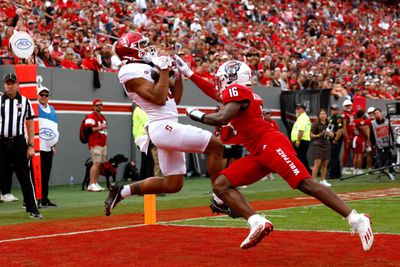
Photo by Lance King/Getty Images
Best Red Zone Target
It’s hard to find receiving stats broken down by field position, so for this one I relied on a report on Power Four receivers from PFF, although I elevated Savion Williams over Zakhari Franklin based on red zone productivity.
Class Leader: Elic Ayomanor, Stanford – PFF Red Zone Receiving Grade : 89.2
6-2, 206 lbs | 4.44 sec 40 | 1.58 sec 10-yd | RAS 9.56
2024 Receiving: 57.8% rec | ADOT 14.2 yds | 831 yds | 6 TD | 1.90 Y/RR | 3.9 YAC/rec | 14/29 CTC (48.3%) | 8.7% drops
Red Zone: 9/12 rec (75%), ADOT 15.9 yds, 136 yds, 6 TDs, 3.02 Y/RR
Consensus Rank: 75
Ayomanor is 21 year old red-shirt sophomore hailing from Red Hat, Alberta. With just two years of collegiate starting experience, he is still learning the position. He lacks burst, but plays with good body control to make acrobatic catches and long speed to beat defenders deep. He posted good receiving numbers in his second season starting, and really tore it up in the red zone. He was not helped by a QB frequently throwing to him in traffic.
Honorable Mentions:
Jayden Higgins, Iowa State – 4/6 CTC (66.7%), 108 yds, 8 TD, 2.45 Y/RR (consensus rank 56)
Tai Felton, Maryland – 12/18 rec (66.7%), 8 TD, 2.38 Y/RR (consensus rank 123)
Emeka Egbuka, Ohio State – 11/16 rec (68.7%), 97 yds, 6 TD, 3/6 CTC, 2.06 Y/RR (consensus rank 28)
Savion Williams, TCU – 8/12 rec (75%), 68 yds, 6 TD (consensus rank 91)
Best Run Blocker
PFF blocking grades are controversial. I’m not fully comfortable with them. But they offer convenient grading of the entire draft class, all in one place, so I’m rolling with them.
Class Leader: Da’Quan Felton, VA Tech – PFF Run Block Grade 80.4
6-5, 213 lbs | 4.5 sec 40 | 1.52 sec 10-yd | RAS 8.99
51.9% rec | ADOT 13.6 yds | 360 yds | 2 TD | 1.39 Y/RR | 4.5 YAC/rec | 8/15 CTC (53.3%) | 13.5% drops
Consensus Rank: 297
Da’Quan had a real drop in productivity 2024 due to poor QB play and scheme fit. His numbers from his previous two seasons at Norfolk and VA Tech were much better. He is a big WR, with the play strength and speed to beat press and outmuscle defenders on deep routes. He is widely considered to be the best run blocking WR in the draft class. The Commanders might be able to pick him up on discount as WR depth late in the draft or after it’s over.
— James Foster (@JamesFosterNFL) November 27, 2024
Honorable Mentions:
Tre Harris, Ole Miss – PFF 76.1 (consensus rank 68)
Samuel Brown, Miami – PFF 76.1 (consensus rank 256)
Chimere Dike, Florida – PFF 75.9 (consensus rank 232)
Bru McCoy, Tennessee – PFF 75.8 (consensus rank 270)
Jack Bech, TCU – PFF 74.5 (consensus rank 66)